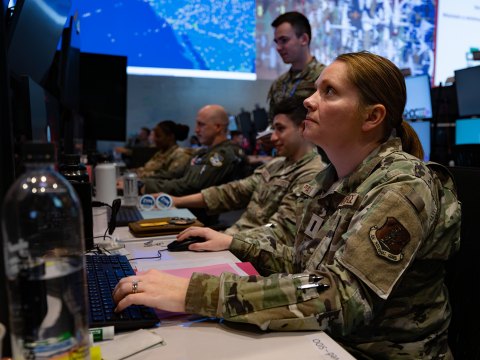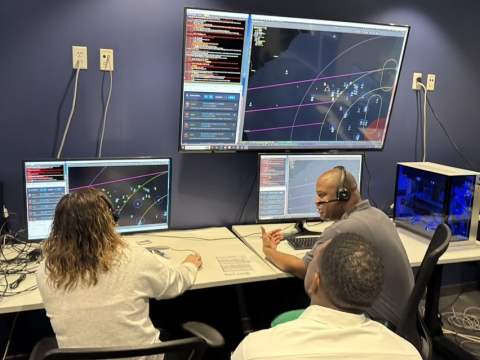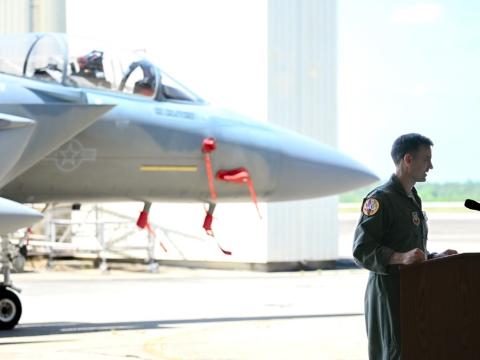Command Crafts The Missing Links
 |
Wearing chemical warfare gear, Staff Sgt. Tamara Needle, USAF, 355th Communications Squadron, checks her e-mail during a recent exercise. Brig. Gen. Steven J. Spano, USAF, director of communications (A-6), headquarters, Air Combat Command (ACC), believes that service members should have a computer interface other than e-mail that encourages collaboration. |
Creating a culture of collaboration is a top priority for the lead communicator at the Air Combat Command. The objective may appear easy to achieve—simply a matter of issuing an order that everyone use technology to operate as one force—but in reality, several challenges stand in the way. As the ranks of next-generation
The transition to new, faster and more efficient ways of communicating within the Air Force and the joint world is a top priority for Brig. Gen. Steven J. Spano, USAF. The director of communications (A-6), headquarters, Air Combat Command (ACC), Langley Air Force Base, Virginia, Gen. Spano is no stranger to promoting collaboration. For several years in communications roles in
The general points out that the Air Force, like the other services, is finding ways to encourage open information sharing in a population that comprises what he calls both “analog” and “digital” natives. This circumstance alone poses myriad challenges that he feels will be overcome given time.
Air Force Space Command, Peterson Air Force Base,
“We are trying to create a culture of collaboration to increase the speed of decisions and the quality of content,” the general says. Some of the tools the ACC is examining to accomplish this task fall into the social networking category. However, to use them, a functional process and plan is needed just to keep pace with capabilities that are being introduced so rapidly into the marketplace. Despite this challenge, Gen. Spano believes that it is critical that Air Force networking practices attain the level found in the private sector.
One reason the general considers incorporating social networking and other collaborative tools into the service imperative is that he predicts a future work force shortage. “That means that the competition for talent and resources will be incredible,” he relates.
Today, the people, procedures and processes in the Air Force as well as in the U.S. Defense Department in general are rooted in analog thinking. Although many experienced airmen are striving to cross the analog-to-digital threshold, when new recruits join the service they discover that the policies and doctrines reflect this analog thinking. Many find the restrictions that prevent instant community communications difficult to understand and handle. “Speed is normal to them. Integration is part of their lives. They assimilate information technology; we accommodate it,” Gen. Spano notes.
This situation will make it difficult to recruit talented information professionals as the need for them increases and the pool shrinks. “They will go where they can be challenged and have the freedom to work where, when and how they want. The question is: How do you blend a need for a more structured environment and processes and yet introduce the various digital ways that they operate and think to attract innovation and talent? Creating a culture of collaboration isn’t just a bunch of buzz words when you peel it back into how we create that environment that’s going to attract the top talent of this younger generation,” the general contends. Enticing information technology professionals by renovating the way service members are allowed to collaborate is critical because the Air Force will not have the resources to function using analog processes in a digital world, he adds.
The benefits of building an enterprisewide collaborative environment go beyond meeting recruitment goals. Gen. Spano points out that pulling together information about airmen’s work experiences and former duty stations can create a compilation of knowledge that others can tap into from wherever they are whenever they need it. In addition, the service could follow the lead of the commercial sector and create a reference tool that leads airmen to related information. For example, the Air Force could imitate Amazon.com’s feature that grasps a user’s interests and suggests related material.
The challenge in establishing such a knowledge consortium is determining how to ensure that service members keep their information current and that they add to the knowledge base regularly. The latter poses the problem of determining how to measure and evaluate the amount of airmen’s participation in the environment, Gen. Spano admits.
 |
The U.S. Senate denied additional funding for the F-22 last July. To address the deficit in aircraft platforms, the ACC is ensuring that current F-22s are as lethal as possible and is fielding its second fifth-generation aircraft, the F-35. |
For many years, Gen. Spano has been a proponent of using technology to collaborate, but today his fervor has increased as fast and as furiously as the tools themselves. Rather than restricting new airmen in the use of new capabilities, the general would like to unleash young airmen, see how they use collaborative tools, then share best practices and incorporate them into policies. One capability that the general believes would be particularly useful online is presence—the ability to know who is online.
“We’re finding that if you can get away from using e-mail as the front end [of communicating], you have to create a new front-end that’s role-based and interactive. At times, you have to think your way into acting, and there are times when you act your way into new ways of thinking. The capabilities are out there. We have to act our way into a new mindset, and [the question is] how do you generate that momentum?” he says.
One technical solution Gen. Spano suggests is to create a dashboard that features the tools users need and gateways to other networks. This computer interface would have to be customizable and role-based so that access to specific information can be controlled, he adds.
The general admits that it is difficult to determine exactly where the Air Force stands in the process of creating a community of collaboration. On one hand, the use of collaborative tools is in its infancy; on the other hand, the service is in the position of new parents, learning how to help new processes, procedures and doctrines grow. Gen. Spano relates that other major commands are facing the same opportunities and issues, and a community of sharing has grown up around this activity. “We haven’t pulled together with clarity a full end-to-end [idea of] what our end state will be, but we’re working toward that in the Knowledge Operation Enabling concept that is in draft form right now,” he states.
Gen. Spano’s passion for adopting collaborative tools is not just about sharing knowledge for its own sake. Once in place, these capabilities can have real effects on the battlefield. For example, when commanders have questions about weapons platforms, they could look across the Air Force enterprise and directly contact the appropriate expert. This communication can take place in a matter of seconds, which is intrinsically valuable but hard to measure, the general admits.
The question is how to make this exchange of information more viable, and perhaps the answer is collaborative networking. Although this already is being done in the commercial sector, the military does not have the agility it needs to mimic its techniques and processes. Gen. Spano adds that increased collaboration must be not only a part of the service’s business doctrine but also a part of its operations processes. Air operations centers of the future will require these capabilities. To make progress in this area, the ACC is examining how it would support the architecture warfighters would need to tap into data, voice and full-motion video on demand, the general explains.
In
At this point, the ACC is supporting 50 combat air patrols (CAPs) in the war effort. Each CAP consists of four RPAs: one on its way to patrol, one patrolling an area, one returning from patrol and one being readied to fly. Gen. Spano explains that the challenges CAPs present include building the architectures and connectivity as well as supporting the processing, exploitation and dissemination process. The goal is to move information gathered by the aircraft through analysis and to the places it is needed quickly. A system of systems approach is being used, he explains. In the future, the goal is to increase the number of CAPs to 65.
The remotely piloted and other aircraft are likely to play a larger role in future combat operations now that funding for additional F-22s has been curtailed. The RPAs will continue to provide robust intelligence, surveillance and reconnaissance (ISR) information, extend the command and control infrastructure, provide a persistent strike capability and may be involved in air-to-air combat in the future.
Gen. Spano points out that this shift brings up the topic of force generation. It will require a change in training as conventional air superiority using traditional aircraft moves to the use of fewer piloted missions and a greater dependence on RPAs. From an information technology perspective, the question that must be answered as soon as possible is where the missions will be conducted. “We’ll get there. There’s no doubt about that. But the question is where do you get the bandwidth to the places that they want to establish as the hub to fly these [RPAs],” the general explains.
The RPAs are not the only ISR platforms the ACC team must help support in current operations. Gen. Spano notes that the new MC-12, developed in response to Secretary of Defense Robert Gates’ call for more ISR assets, has been a “significant success.” A technology-loaded commercial aircraft, the first MC-12 is designed to augment information gathered by other intelligence-gathering platforms and provides real-time full-motion video and signals intelligence to commanders. Its maiden combat sortie took place in
In terms of air superiority in light of fewer-than-expected F-22s, ACC officials say the Air Force is mitigating the risk as much as possible by ensuring that the F-22 is extremely lethal. In addition, the service is fielding the F-35, its second fifth-generation aircraft, and is modernizing its fourth-generation fighters where appropriate. The service will focus on gaining air superiority at specific decisive points during operations to achieve the mission. In certain situations, the Air Force will concentrate on localized rather than broad and constant air superiority, ACC officials state.
In addition to dominating the air domain, the Air Force has made giant leaps in the cyber domain. Gen. Spano relates that it established the 24th Air Force, which has overall responsibility for managing the Air Force network. It also will determine how the service will interact with the U.S. Cyber Command, a sub-unified command of the U.S. Strategic Command.
Gen. Spano emphasizes the importance of this mission. At this point, the
WEB RESOURCES
Air Combat Command: www.acc.af.mil
24th Air Force: www.24af.af.mil
MC-12 video: http://bit.ly/6almX9




Comments